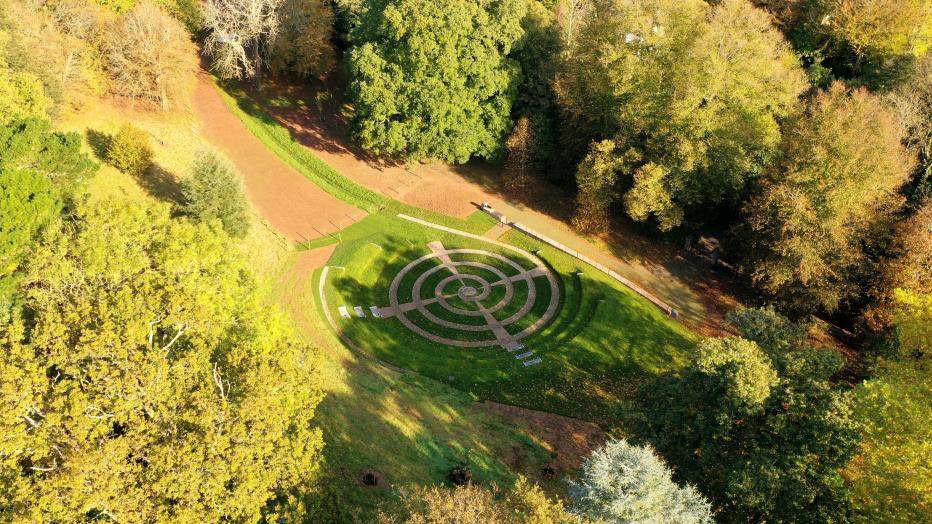“Sidmouth is lumbered with an impressive white elephant that has set back the biodiversity of a locally important site for years. It would have been far better and cheaper to use the water meadow as an attenuation lagoon.” [Local amateur naturalist, Ed Dolphin]
.
Some four years ago, the county council submitted a planning application for a flood alleviation scheme comprising a drainage swale and grassed amphitheatre designed to attenuate surface water runoff and provide a venue for public events – and so to great fanfare three years later the ‘Knowle amphitheatre’ won an engineering prize, as proudly laid out by the engineers behind it:

Sidmouth Amphitheater: Flood defenses with a theatrical twist | Jacobs
Tomorrow, there will be a talk and site visit, as part of the Sidmouth Science Festival:
Sidmouth Amphitheatre – a flood defence hidden in plain sight
Wednesday 11th October 2023 2:30 PM
Location/Venue: All Saints Church Hall EX10 8ES
The flood alleviation scheme located at the Knowle Arena in Sidmouth is a unique blend of public performance space, parkland, somewhere for people to socialise, and ultimately to divert and temporarily store surface water. This talk will explain the development of this project from identifying Sidmouth as a high risk flood location, to the solution development which began with a more traditional approach, before evolving into the multi-use space.
With Paul Hargreaves, Senior Associate Director of Water and Environment, and Gloria Rugual Munoz, Water Engineer, Jacobs. This talk has been organised in partnership with the Sid Vale Association. Entry £2.50. Refreshments available.
Here is an alternative narrative from local amateur naturalist Ed Dolphin – who has generously given permission to publish his letter to Paul Hargreaves of Jacobs, sent prior to tomorrow’s event:
Knowle, Sidmouth
The scheme may have won an engineering award but I would not give it an environmental award, and local groups have rejected the amphitheatre as a performance space for a number of reasons mainly to do with the complicated floor surface and lack of potential for off stage operations. The grass cutting contractor has great difficulty with the terraces and it is going to cost the council far more to maintain the area than was the case when it was a conventional area of parkland.
The ‘wildflower’ areas are a disaster, mainly because of the seed mix used. The largest area north of the Horse Chestnuts was a functioning water meadow with good diversity. You were warned that it was under water for half the year and this would making earth moving difficult. Having dumped all the spoil from the excavations on the area and raising it by more than a metre, that habitat has now gone forever.
The seed mix sown in the swale and across the area has compounded the damage. As happens so often, the commercial seed mix has produced an impressive display of flowers that delights some people but the local invertebrates are less impressed.
There is the usual problem of including annual arable plants such as Poppy, Corn Marigold and Cornflower which need the ground to be ploughed if they are to flower in year two.
There are introduced species such as Dianthus carthusianorum and Echium plantagineum. These are close relatives of truly native species which are very pretty but local pollinators do not recognise them as a food source and do not visit them very much. Several of the native species such as Silene latifolia and Thlaspi arvense do not occur in our valley and county botanists are unhappy about their introduction.
The most significant problem is that the sown species that do occur in our local population appear to be robust cultivars rather than wild stock. We have lots of Wild Carrot on the local cliffs where it grows to a height of about 50cm. The area beside the car park of the Knowle site was swamped with the same species this summer but it was a forest of plants nearly 2m tall. Again. local pollinators do not recognise them as a food source and ignore them largely. I took a short video in the area on a sunny day in August and there were hardly any insects flying. I visited the site for July’s Big Butterfly Count. The floral extravaganza of the ‘wildflower’ area had one Large White in the count period. 100m away in the grassland area of the park beyond the amphitheatre there were Commas, Gatekeepers, Meadow Browns, Ringlets, Large Skippers and Red Admirals as well as the Large Whites. The old water meadow would have yielded similar results.
Burying the water meadow under the spoil was bad enough but the biodiversity loss could have been reduced if you had cut and collected green hay from the park and laid on the bare ground to let nature takes its course. I suggest you explore this possibility for future projects. If there isn’t a site specific source, then explore other local sources of seed rather than commercial suppliers.
I am sorry this is so negative but I really think Sidmouth is lumbered with an impressive white elephant that has set back the biodiversity of a locally important site for years. It would have been far better and cheaper to use the water meadow as an attenuation lagoon.
…